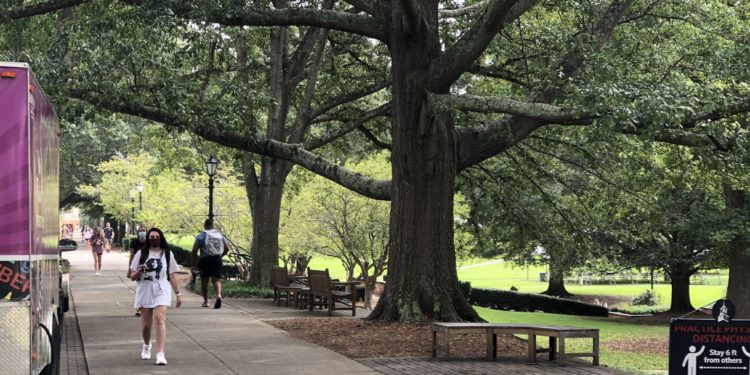By: Katy Beth Boyers
Over the summer, hundreds of Samford University’s faculty and staff put in hours of work to prepare campus for this fall semester. The resulting plan became known as “Bring Back the Bulldogs,” which includes guidelines that students and faculty must follow if they are on campus, details COVID-19 testing protocols and outlines the option for professors to have online, in-person or hybrid classes.
Samford University President Andrew Westmoreland said the university will try to have students remain on campus until Thanksgiving. Westmoreland said that so far, there are things that have been done well, and he acknowledged that some areas within the Bring Back the Bulldogs plan need some improvement.
“We are doing I think better now than when we did initially, especially with all of the masking and distancing,” Westmoreland said. “I began to be concerned in the first two or three days after classes began when, even though I wasn’t seeing it, a lot of people just weren’t wearing masks. This isn’t just students, this is all of us.”
After the first week, students received an email from Phil Kimrey, the Vice President of Student Affairs and Enrollment Management, reminding students of the Return to Campus guidelines. These included rules such as: wearing a mask whenever in class and on campus — with the exception of students’ dorms — and observing social distancing practices at all times.
“We have doubled down on that a bit more to make clear of our expectation without putting too much blame or being too harsh, I don’t think that works,” Westmoreland said. “But, by and large I am very much pleased with the progress we have made on that.”
Westmoreland also mentioned the upcoming sentinel testing that will be done on campus. However, he clarified that it is not just random testing, but will be focused as well.
“If we see two or three new cases in a residence hall, in all likelihood, we are gonna go more directly to where those new cases are and do more focused testing so that we can stay ahead of whatever might be emerging,” Westmoreland said.
Overall, Westmoreland said he would give the Bring Back the Bulldogs plan so far mixed reviews, and added that while there are things that have worked so far, there are other issues that are currently being addressed. One thing that he said he has really appreciated is the boards placed along Ben Brown Plaza and the Quad that have students, faculty and Westmoreland himself, holding up a whiteboard with messages of why they wear masks.
“Those are not just happy messages, those are sobering,” Westmoreland said . “I think that within the consciousness of the campus, both for students and faculty and staff, people really understand that if we are going to get to Nov. 24, then it’s on each of us to do our part.”
Looking forward, Westmoreland said he does think that the sentinel testing will be something students, faculty and staff will find annoying and inconvenient. However, he believes that these sentinel tests will be important to stay on top of any potential spread of COVID-19 on campus.
“For instance, if I pop up into the random numbers for having to do another test, I’m probably not going to like that much and it’ll be a little bit of an inconvenience,” Westmoreland said. “We will need as a campus to try to adapt to that because I think that’s going to turn out to be crucial for us in staying a step ahead to where some of the problems may be.”
When it comes to the increasing number of COVID-19 cases on campus, Westmoreland said he believes that there will be a small number of cases throughout the semester.
“Of course I would hope that we will see the numbers just hold where they are or go down a bit. I don’t think the numbers will go down to zero. That is not an aspirational hope that I am going to wake up in the morning and that report that came in the middle of the night is zero,” Westmoreland said.
Westmoreland said that if they start to see a rising number of cases daily, the administration will do one of two things: they will either close campus down but not send everyone home, or do what was done this spring and send everyone home. However, he assured students that they are not making those kinds of decisions yet, but cautioned that it could happen very quickly.
“I wouldn’t sugarcoat it; it’s a distinct possibility that we would have to do that,” Westmoreland said. “We’re not there now, and we want to do everything we can in as smart of a way as we can to prevent that from happening.”
The closure of campus during spring break was a major learning experience for Samford administration, students and faculty. Westmoreland expressed his appreciation for the faculty for being able to quickly transition to online instruction when campus shut down during spring break and the remainder of the semester.
“That was a massive burden on them, to re-envision what the remainder of those courses would look like and to do it with a degree of credibility,” Westmoreland said. “I appreciated all of that.”
Throughout the month of March, Westmoreland and the administration worked to figure out details from one moment to the next. It wasn’t until April that the university started to work on a plan to have students return to campus in the fall.
“By April, we knew then that the entire semester was gonna be virtual and so those plans started to level out a bit and we were able to begin to think about what elements we are already learning that could be incorporated into plans for the fall,” Westmoreland said.
With the development of a continuity of instruction team and an operational team that deal with residence halls and food services, the Bring Back the Bulldogs plan took shape .
Westmoreland said he believes Samford University has grown a lot from this pandemic, and was surprised to hear from so many students that wanted to be back on campus. As colleges begin to provide many of their courses online and with there being online education, Westmoreland was afraid that residential college was dying out. Then, he said he started receiving emails from students expressing their appreciation for their faculty, and how much they value being on campus.
“I began to understand that my fears were misplaced, that what we were all really learning was that there is great value in this, and that we probably appreciate it more and probably want it more than we did before we had to close the campus this March,” Westmoreland said.
He also said that Samford has not had enrollment issues like other universities are experiencing.
“Our students returned, our entering undergrad students came in unexpectedly high numbers, so all of those things I was thinking last March might be indicators of the dying way of not just the Samford model but this small residential campus model, all those small things that I was worried about, that didn’t pan out,” Westmoreland said.
Looking forward to future Samford traditions that are normally held during the fall semester, including Homecoming, Westmoreland said the university is working to do what it can, but as he looked outside from his office and saw students sitting outside studying or running around while socially distancing, he said he is willing to sacrifice big events if it means students get to stay on campus this semester.
“We will do the best that we can for it all. It’s not a cause for celebration, but if sacrificing those events enables us to do that,” he said as he pointed outside to students running around, playing and sitting on the quad, “and maintaining classes and forging relationships one on one, then that’s alright for now.”








Great article Katy Beth!!